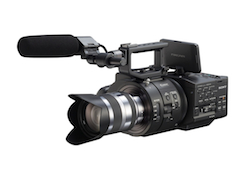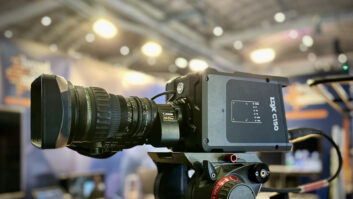
NAB is awash with tools for acquiring, storing, post producing and displaying resolutions four times greater than HD, writes Adrian Pennington. Among them is product from Canon and Sony which are intended to bring the imaging capability further within the realm of broadcast and indie film budgets. Canon is to bring out the C500, shown in prototype at NAB, which is a 4K- and 2K-capable model in its Cinema EOS line with a ‘to be confirmed’ price of $30,000 aimed at features and high end drama. It also has a new digital SLR camera with 4K support, the EOS-1D C, priced at $15,000. Meanwhile Sony is debuting a $10,000 4K-capable camera with a super slow motion mode for promos, commercials and documentaries as well as sports. Available in June, the NEX-FS700 (pictured) is initially intended for HD use but will be able to output 4K by way of a firmware upgrade and recorder at a later date. Other camera vendors with 4K plans include: Weisscam which is to release a 4K model capable of hi-speed shooting at 450fps; Panasonic which has a prototype and no release date for a 4K model of its Varicam based on the AVC Ultra codec, and JVC which is marketing a camcorder sporting a 4K-ready sensor. Panavision is also readying a digital cinema camera, rumoured to be 4K, for launch in Q2 this year. Specifics on the C500 The C500 ups the resolution from Canon’s HD digital cine camera C300, to 10-bit 4K (4096×2160). These raw files are output to an external recorder via dual 3G-SDI output and without the de-Bayering filter process common to many digital imagers. It will also be able to output 2K at 12-bit 4:4:4 RGB or 10-bit YcrCb and enables frame rates up to 120fps. It can simultaneously record at 50Mbps HD video making it compatible with HD broadcast delivery specs, or for offline editing purposes. The camera will have a new ‘Super 35mm-equivalent’ CMOS raising the resolution from 8.3 megapixels in the C300 to 8.85 megapixels. It is available in two versions: one with Canon’s EF lens mount and one with a PL Mount. Specifics on the NEX-FS700 The NEX-FS700 has a Super 35 sized CMOS sensor and is capable of capturing 480 fps and 960 fps at reduced resolution. It will deliver Full-HD quality images at 120 and 240 fps in an 8 or 16 seconds bursts. The NXCAM’s E-Mount will carry most SLR and DSLR 35mm lenses. The camcorder also includes face detection and auto focus to help ensure the subject is always kept in focus. Compatible media includes MS and SD memory cards and Sony’s HXR-FMU128 flash memory unit that attaches to the camcorder. Sony is planning a future firmware upgrade that will enable the NEX-FS700 to output 4K bit-stream data over 3G HD-SDI when used with an optional Sony 4K recorder. 4K to the home A number of manufacturers — including Barco, Toshiba, Samsung and TVLogic — are showing 4K monitors for the set, the edit room and the home. Canon previewed a 30-inch 4K reference display. Sony has a 4K-ready home projection system as well as a lead in 4K theatrical projection installations while Red is also to debut a 4K home theatre system. Content released in the format is limited – but growing. A number of films including the forthcoming Spider-Man and Skyfall will be distributed in 4K. Peter Jackson’s The Hobbit was shot on multiple Red Epics at 5K and Will Smith sci-fi vehicle After Earth, from director M. Night Shyamalan (The Sixth Sense), is one of the first productions to use Sony’s F65 which outputs 4K from an 8K chip. At the Sony press conference, TV Globo demonstrated footage it had shot in 4K on Sony F65’s of the Rio carnival, making the case for documentaries to be shot in 4K now. Anecdotal evidence also suggests that live theatre and music performances are being trailed in 4K for archive. Just now though, the main reason to shoot 4K is for the increased detail it provides the editing and compositing process, where any manipulation of the image decreases the origination quality. Although broadcasters have barely settled their investments in HD production and transmission equipment, there will inevitably be a leap in broadcast resolution. The NHK-backed Super Hi-Vision is most notable. It packs a resolution sixteen times higher than HD – 7680 x 4320 pixels – with transmission tests in-conjunction with the BBC during the London Olympics and a satellite broadcast trail set for 2015. Standards body ITU is drafting parameters for a UHDTV signal format which includes a 16×9 aspect ratio, progressive only, 10 and 12 bits precision and framerates up to 120fps. MPEG HEVC, expected to be ratified as an international standard in July, will also support UHDTV but limited to 8 bits in the initial version. French research consortium 4EVER expects to demonstrate a first complete Ultra HD production and transmission chain by mid-2013 with several field trials planned for sports events, music concerts and other live shows. Its work will encompass both the full Super Hi-Vision format, but also possible intermediate 4K or QFHD (Quad Full HD) formats. According to Benoit Fouchard, Chief Strategy Officer of consortium member, ATEME; “Our story today is HEVC centric. For all these higher than HD resolutions, HEVC looks like a good candidate compression scheme and an enabler of more ‘workable’ operating bitrates. We see traction with a number of telecom operators worldwide, and therefore we formalised a research group to prepare a first industrial implementation end to end.” On the production side, the lead partner in the project will be France Televisions which showed 4K captured material at NAB.







